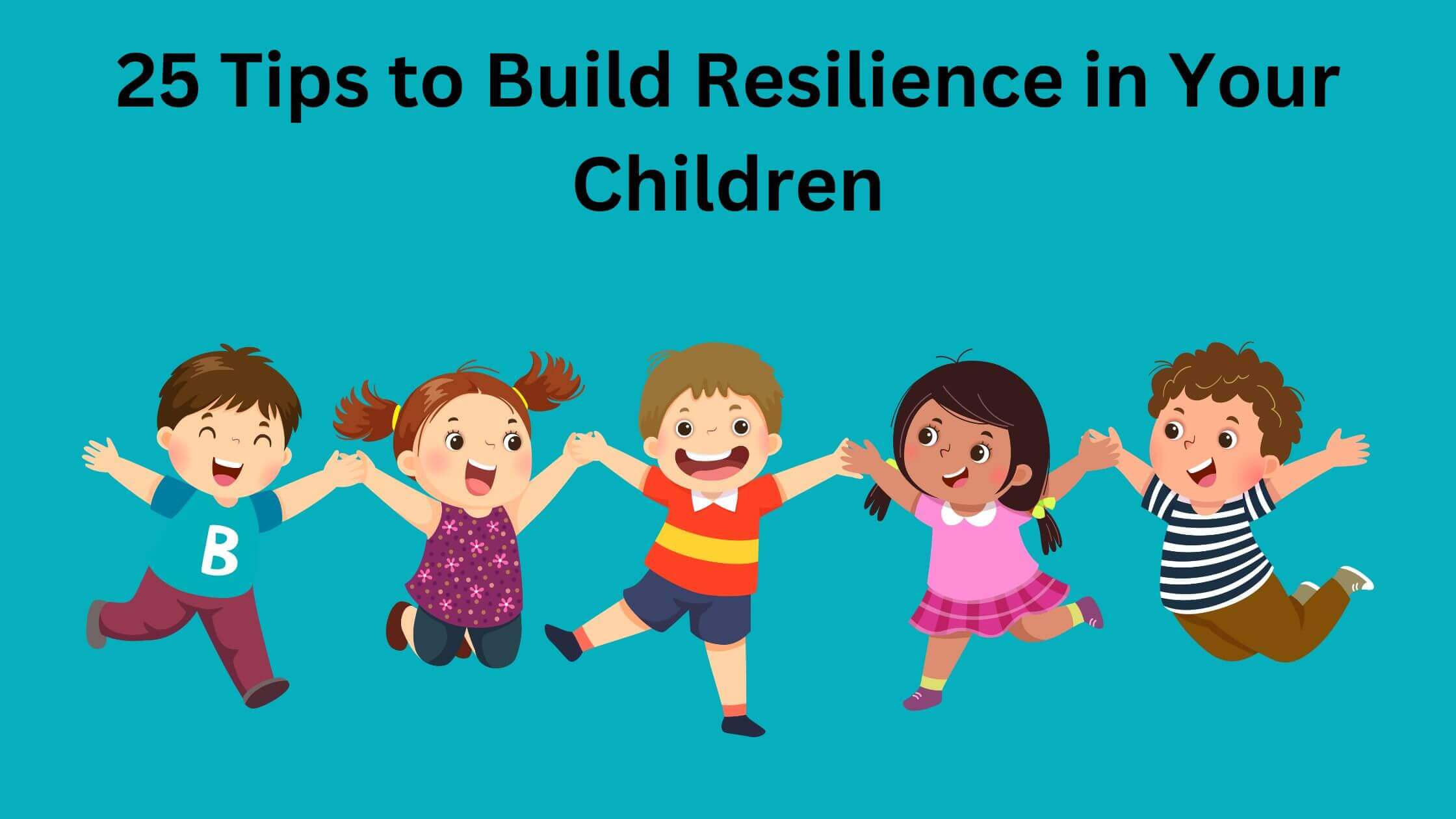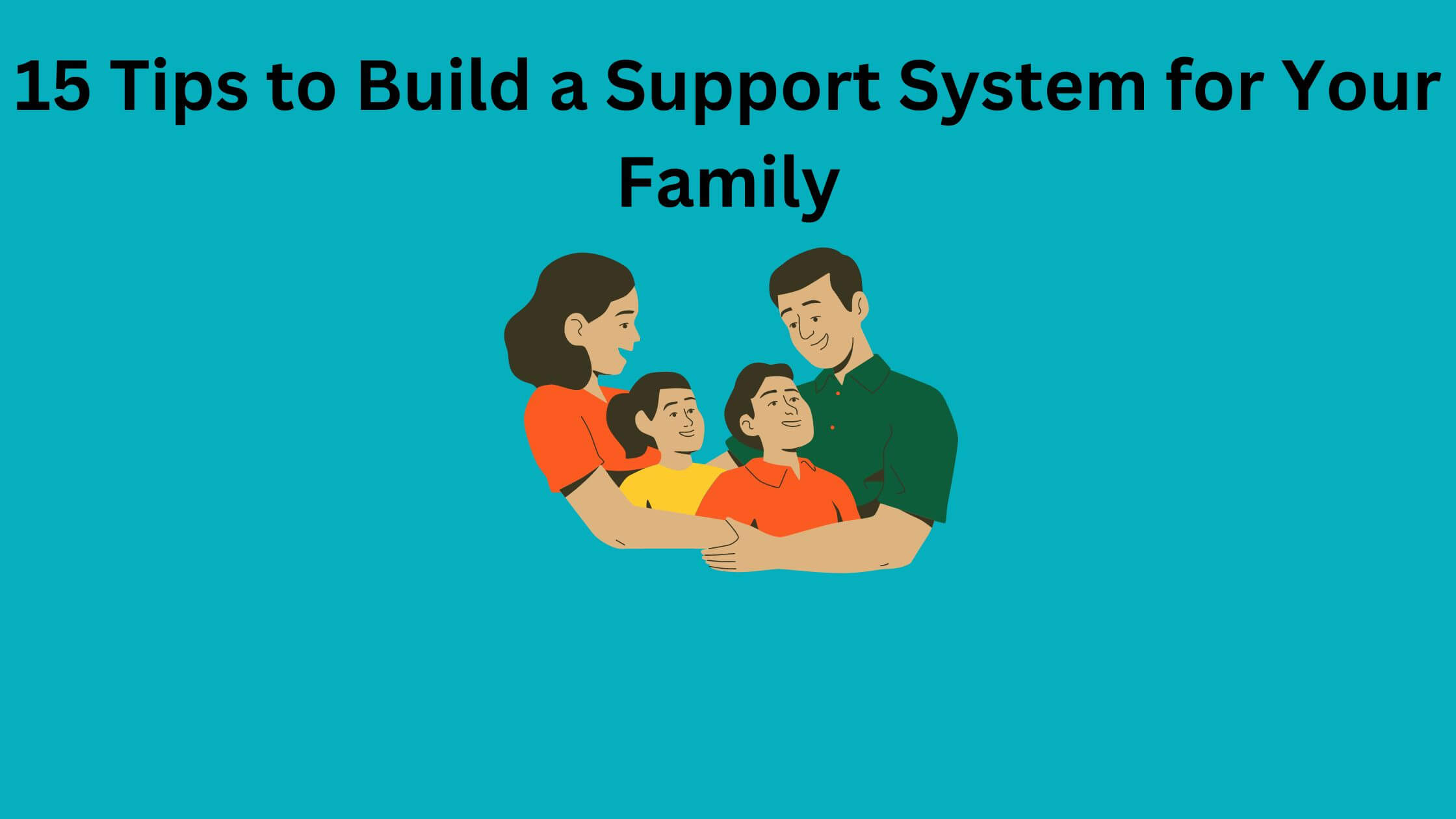You want your children to be able to handle life’s ups and downs with ease, don’t you? To be able to bounce back from setbacks and keep pushing forward toward their goals.
But how do you build resilience in your children? It’s not something that can be bought or taught in a single lesson. It’s a lifelong process that requires a combination of techniques and strategies that, when used together, create a strong foundation for resilience.
In this article, we’ll explore 25 tips to build resilience in your children. These tips cover a range of areas, from fostering a growth mindset and teaching problem-solving skills to promoting healthy eating habits and encouraging physical activity.
By following these tips, you’ll be helping your children develop the tools they need to face life’s challenges head-on and emerge stronger and more resilient than ever before.
So, let’s get started.
Key Takeaways
- Building resilience in children is a lifelong process that requires a combination of techniques and strategies, consistency, patience, and fun.
- Resilience can be built through fostering a growth mindset, teaching problem-solving skills, promoting healthy habits, teaching mindfulness and relaxation techniques, developing emotional intelligence, encouraging creative expression, building strong relationships, teaching time management skills, practicing gratitude, instilling a sense of purpose, teaching adaptability and flexibility, and promoting positive social interactions.
- Building self-esteem and confidence in children can be achieved through celebrating strengths and accomplishments, encouraging trying new things and taking risks, being a positive role model, encouraging independence and responsibility, and giving age-appropriate tasks.
- Teaching resilience through independence and responsibility involves identifying positive role models in the child’s life, incorporating resilience-building activities, teaching resilience as a learned skill, developing coping strategies, encouraging problem-solving, encouraging risk-taking, setting up safe and controlled opportunities for risk-taking, normalizing failure, focusing on effort, not outcome, celebrating progress made along the way, incorporating affirmations and gratitude exercises into daily routines, and learning how to bounce back from negative outcomes.
How to Build the Resilience of Your Children
1. Encouraging Positive Self-Talk
You gotta talk to yourself like you’re your own best friend, and give yourself some pep talks to boost your confidence. This is a great way to encourage positive self-talk and build resilience in your children. By promoting self-affirmation and self-love, you’re teaching your kids that they can rely on themselves, even in tough situations.
One of the easiest ways to teach kids positive self-talk is to model it yourself. Speak to yourself kindly and positively, and your children will pick up on that behavior. Encourage them to do the same by asking them questions like, “What’s something you’re proud of?” or “What’s something you did well today?” This helps them focus on their successes and strengths, rather than their failures.
There are also other everyday ways to teach kids how to build resilience through positive self-talk. For example, you can use encouraging phrases like “I believe in you” or “You can do it” when your child is facing a tough situation. Additionally, you can help them reframe negative thoughts by asking questions like, “Is that thought helpful or hurtful?” or “What’s another way to look at this situation?” When you do so, you’re teaching them how to reframe their thinking and stay positive, even when things get tough.
2. Fostering a Growth Mindset
Imagine your child approaching a challenging task with excitement and determination, knowing that their effort and perseverance can lead to growth and success. This is possible when you foster a growth mindset in your child.
A growth mindset is the belief that one’s abilities can be developed through hard work and dedication. It is the opposite of a fixed mindset, which is the belief that one’s abilities are set and cannot be changed.
To teach resilience and develop a growth mindset in your child, you can encourage them to take on challenges and view failures as opportunities to learn and grow. One way to do this is to praise their effort and perseverance, rather than just their achievements.
You can also engage them in resilience activities and coping strategies, such as problem-solving, positive self-talk, and mindfulness.
Another way to foster a growth mindset is to model it yourself. Show your child how you approach challenges with a positive attitude and a willingness to learn. Let them see you make mistakes and learn from them.
By doing this, you are teaching your child that failure is not something to be feared, but rather an opportunity for growth and improvement. With these strategies, you can help your child build resilience and develop a growth mindset that will serve them well throughout their lives.
3. Teaching Problem-Solving Skills
Teaching problem-solving skills can be crucial for your children’s success, as studies show that individuals who are effective problem-solvers are more likely to achieve their goals and have higher levels of satisfaction in life.
As a parent, you can help your kids build resilience by teaching them how to cope with adversity and develop problem-solving skills. Here are some tips to get you started:
- Encourage your children to think creatively: When faced with a problem, encourage your kids to think outside the box and come up with creative solutions. This will help them develop critical thinking skills and build confidence in their ability to tackle challenges.
- Teach them how to break down problems into smaller, manageable tasks: When faced with a big problem, it can be overwhelming for anyone, especially for kids and teens. Teach your children how to break down a problem into smaller, more manageable tasks. This will help them feel more in control and confident in their ability to solve the problem.
- Model problem-solving skills: Children learn best by example, so be sure to model problem-solving skills in your own life. When faced with a challenge, talk your kids through your thought process and how you plan to tackle the problem. This will show them that problem-solving is a valuable skill that can be learned and practiced.
By teaching your kids resilience and problem-solving skills, you are helping them develop important life skills that will serve them well in the future. Encourage them to think creatively, break down problems into smaller tasks, and model problem-solving skills in your own life. With your guidance and support, your children will be better equipped to face any challenge that comes their way.
4. Encouraging Physical Activity
Encouraging physical activity can be a fun and engaging way for kids to stay healthy and active. It’s also an effective way to build resilience in your children. Physical activity helps children learn how to cope with adversity and develop problem-solving skills. As a caregiver, it’s important to encourage your kids to be physically active on a regular basis.
One way to encourage physical activity is to make it a family activity. Go on hikes, bike rides, or even just walks together. This not only encourages physical activity but also creates a bonding experience for the family.
You can also try signing your kids up for sports teams or classes. This allows them to be active while also learning new skills and building relationships with their peers.
Physical activity can also be a great way for kids to relieve stress and anxiety. It helps them release pent-up energy and emotions in a healthy way. By encouraging your kids to be physically active, you’re teaching them important coping skills that they can use throughout their lives.
So, make sure to prioritize physical activity in your kids’ lives and watch them grow into resilient and healthy individuals.
5. Promoting Healthy Eating Habits
Eating healthy can be a game-changer for your family’s overall well-being, so let’s explore some ways to make it fun and enjoyable. Here are some tips to help you promote healthy eating habits in your children:
- Make it a family affair. Involve your children in meal planning and preparation. Let them choose fruits and vegetables they want to try. Make a game out of it by having a ‘taste test’ or creating fun, colorful plate designs.
- Lead by example. Children learn by watching their parents. Make sure you’re also making healthy food choices and eating a balanced diet. Avoid using food as a reward or punishment.
- Explain the benefits. Talk to your children about why it’s important to eat healthy. Teach them about the nutrients in different foods and how they help our bodies grow and stay healthy. Encourage them to try new foods and be open-minded.
By promoting healthy eating habits, you’re not only helping your children develop resilience but also teaching them problem-solving skills. Healthy eating can lead to better physical and mental health, which in turn can help them cope with challenges they may face in life.
Remember to be patient and consistent, and don’t forget to have fun!
6. Teaching Mindfulness and Relaxation Techniques
Take a moment to breathe deeply and relax your body, allowing yourself to fully immerse in the mindfulness and relaxation techniques that can drastically improve your mental and emotional well-being.
As parents, we all want our kids and teens to grow up strong and resilient, able to cope with life’s challenges. Teaching mindfulness and relaxation techniques is a powerful way to help them develop the inner resources they need to thrive.
Mindfulness is the practice of staying present at the moment, fully aware of your thoughts and feelings without judgment. It’s a simple but powerful way to reduce stress and anxiety, improve focus and concentration, and boost overall well-being.
You can start by teaching your kids to take a few deep breaths and focus on the sensation of the breath moving in and out of their bodies. Encourage them to notice any thoughts or feelings that arise, and simply observe them without getting caught up in them.
Relaxation techniques are another powerful tool for building resilience in kids and teens. You can teach them simple techniques like progressive muscle relaxation, which involves tensing and relaxing different muscle groups in the body, or guided imagery, which involves imagining a peaceful scene or situation to help calm the mind and body.
By practicing these techniques regularly, your kids can learn to manage stress and anxiety more effectively and develop a greater sense of calm and inner strength. So, take the time to teach your kids these valuable skills, and watch as they grow into strong, resilient adults who can handle whatever life throws their way.
7. Developing Emotional Intelligence
Developing emotional intelligence is like learning to navigate a complex maze, requiring self-awareness, empathy, and effective communication. Emotional intelligence is the ability to recognize and understand your own emotions and those of others. It also helps you manage your emotions, communicate effectively, and build positive relationships.
Developing emotional intelligence in your child is crucial for building resilience and helping them cope with life’s challenges. Kids’ resilience is the ability to bounce back from difficult situations. Emotional intelligence plays a vital role in developing resilience in children. By helping your child understand their emotions and learn to manage them effectively, you can help them cope with stress and adversity.
Teaching your child to communicate effectively can also help them build positive relationships, which can provide a support system during tough times. There are many ways to help your child develop emotional intelligence. You can start by helping them identify and label their emotions. Encourage them to express their feelings and validate their emotions.
You can also model healthy emotional expression and communication. By teaching your child these skills, you are helping them build the foundation for resilience and the ability to cope with life’s challenges.
8. Encouraging Creative Expression
Get your creative juices flowing by encouraging your child to express their ideas in unique and innovative ways. Creativity is an essential component of resilience, and it can help your child develop problem-solving skills that’ll come in handy throughout their lives.
Here are some ways to encourage your child to express themselves creatively:
- Provide them with arts and crafts materials, such as paint, paper, and clay, and encourage them to explore different techniques and mediums.
- Encourage your child to write stories, poems, or songs, and give them the freedom to express themselves in their own unique way.
- Allow your child to play with different toys and games that encourage creativity, such as building blocks, puzzles, and board games.
By providing your child with the tools and freedom to express themselves creatively, you can help them develop resilience and problem-solving skills. When faced with challenges, they’ll be more likely to think outside the box and come up with innovative solutions.
Remember, creativity isn’t just about making art; it’s about exploring new ideas, trying new things, and thinking differently. Encourage your child to embrace their unique perspective and express themselves in ways that feel authentic to them. By doing so, you can help them build the resilience they need to face whatever life throws their way.
9. Building Strong Relationships
You can strengthen your relationships with loved ones by simply spending quality time together and making an effort to prioritize each other. Building strong relationships is a crucial aspect of developing resilience in children. When kids have a strong support system, they are better equipped to handle challenges and bounce back from adversity.
One great way to build strong relationships with your children is by creating shared experiences. This could be anything from a family game night, to a weekend camping trip, to a simple walk around the neighborhood. By spending time together and sharing new experiences, you are creating positive memories and strengthening your bond.
| Tips for Building Strong Relationships with Your Children |
|---|
| 1. Create shared experiences through activities such as game nights, camping trips, or walks around the neighborhood. |
| 2. Make communication a priority by carving out time each day to talk with your children. |
| 3. Practice active listening and be open and honest with each other. |
| 4. Remember that building strong relationships takes time and effort, but the rewards are worth it in terms of your children’s resilience. |
Following these tips, you can help your children develop the resilience they need to navigate life’s challenges. Building strong relationships with your children is an ongoing process, but it is one of the most rewarding things you can do as a parent. So make an effort to prioritize your relationships, spend quality time together, and communicate openly and honestly. By doing so, you are setting your children up for success in the face of adversity.
10. Teaching Time Management Skills
Now that you’ve built strong relationships with your child, it’s time to teach them essential time management skills. These skills will not only help them in their academic and personal lives but also build their resilience and coping abilities.
As parents and caregivers, it’s crucial to set your child up for success by teaching them the importance of time management from an early age. To start, help your child set goals and prioritize their activities. Have them create a to-do list and encourage them to tackle the most challenging tasks first, as this will help build their confidence and self-esteem.
Teach them to break down bigger tasks into smaller, more manageable ones, and reward them for their progress. This will help them stay motivated and focused on their goals. Next, create a routine and stick to it. Children thrive on structure and consistency, so establishing a set schedule will help them manage their time effectively.
Make sure to include time for homework, physical activity, and downtime. This will teach your child the importance of balancing work and play and help them develop healthy habits that will serve them well into adulthood. By setting your child up for success with time management, you’re building their resilience and empowering them to take control of their lives.
Here are a few more tips to help you teach your child time management skills:
- Encourage your child to use a planner or electronic calendar to keep track of their schedule and deadlines.
- Teach them to estimate how long a task will take and to set realistic timelines for completion.
- Model good time management habits yourself. Children learn by example, so make sure you’re practicing what you preach.
Remember, building resilience in your child takes time and effort, but it’s worth it in the long run. By teaching them essential time management skills, you’re setting them up for success and empowering them to take control of their lives.
11. Practicing Gratitude
Practicing gratitude is a simple yet effective way to cultivate a positive mindset and improve mental well-being. When you teach your children to be grateful, you’re building their resilience and equipping them with a powerful tool to face life’s challenges.
Gratitude helps shift their focus from what they lack to what they have, and this mindset can help them approach difficult situations with a more positive attitude. One way to practice gratitude with your children is to encourage them to keep a gratitude journal.
Each day, have them write down three things they’re grateful for. This exercise helps them focus on the positive aspects of their lives and trains them to look for the good in every situation. As they continue to practice gratitude, they’ll become more resilient and better equipped to handle the ups and downs of life.
Another way to practice gratitude is through acts of kindness. Encourage your children to do something kind for someone else each day and to express gratitude for the people in their lives. This helps them develop empathy and compassion, which are essential skills for building resilience.
When they see the impact their kindness has on others, it reinforces the positive effects of gratitude and helps them cultivate a mindset of gratitude and resilience.
12. Encouraging a Sense of Purpose
Having a sense of purpose is like having a compass that guides us toward our goals and gives our lives meaning. When we instill a sense of purpose in our children, we set them up for success and resilience. It gives them a clear direction to follow and helps them develop a strong sense of determination.
Encourage your children to find their passions and interests and pursue them with enthusiasm. This will help them stay motivated and focused, even when faced with challenges.
One way to encourage a sense of purpose in your children is to involve them in community service or volunteer work. This will help them understand the importance of giving back and making a difference in the world. It will also give them a sense of accomplishment and pride, which will boost their confidence and resilience.
Set aside some time each week for your children to engage in volunteer work or community service. This will help them develop a strong sense of purpose and a desire to make a positive impact on the world.
Another way to encourage a sense of purpose in your children is to help them set goals and work towards them. Whether it’s getting good grades, learning a new skill, or mastering a sport, having a goal to work towards can help your children stay motivated and focused.
Encourage them to break their goals down into smaller, achievable steps and celebrate their progress along the way. This will help them develop a strong sense of resilience and determination, which will serve them well throughout their lives.
By fostering a sense of purpose in your children, you’re setting them up for success and helping them build resilience for whatever challenges they may face in the future.
13. Teaching Adaptability and Flexibility
Teaching adaptability and flexibility is crucial for preparing our kids for a constantly changing world. As parents, we want our children to develop resilience so they can handle whatever life throws their way.
One way to help them do this is by teaching them to be adaptable and flexible in different situations. Start by encouraging them to try new things and step out of their comfort zone. This could be as simple as trying a new food or joining a new club at school. Help them understand that change can be a good thing and that it’s okay to make mistakes along the way. By doing this, you’ll be instilling in them the confidence to face new challenges.
Another way to teach adaptability and flexibility is by modeling it yourself. Show your children how you handle unexpected situations or changes in plans. Talk to them about how you adapt to new environments or challenges. By seeing you model this behavior, they’ll be more likely to adopt it themselves.
Remember, teaching adaptability and flexibility is an important part of building resilience in your children. By encouraging them to try new things, modeling adaptable behavior, and helping them understand that change is a natural part of life, you’ll be setting them up for success in the future.
14. Promoting Positive Social Interactions
You’ll be able to create a positive social environment for your kids by showing them how to be friendly and approachable, like a warm beam of sunshine on a spring day. One way to do this is by setting a good example yourself. Be kind to others, show interest in what they have to say, and make an effort to connect with people in your community. Your child will learn from your actions and will be more likely to adopt these positive social skills.
Another way to promote positive social interactions is by setting up playdates or social activities for your child. This will give them the opportunity to make friends and practice their social skills in a safe and supportive environment. You can also encourage your child to join clubs or sports teams where they can meet other children with similar interests. Being part of a group can help build resilience and self-confidence in your child.
To help your child make friends, you can teach them basic social skills such as how to introduce themselves, how to start a conversation, and how to be a good listener. You can also role-play different social scenarios with your child to help them practice these skills. By giving your child the tools they need to navigate social situations, you are setting them up for success and helping them build resilience. Remember, social interactions are an important part of your child’s development, and by promoting positive social interactions, you are helping them grow into confident and resilient adults.
| Tips for promoting positive social interactions | Examples |
|---|---|
| Be a good listener | Show interest in what others have to say |
| Encourage your child to join clubs or sports teams | Meet other children with similar interests |
| Teach basic social skills | How to introduce themselves and start a conversation |
Remember that building resilience in your child is an ongoing process that requires patience and persistence. By promoting positive social interactions, you are helping your child develop the skills they need to navigate a complex and ever-changing world. Be sure to set a good example, provide opportunities for social interaction, and teach your child basic social skills. With your help, your child can become a confident and resilient individual who is able to face any challenge that comes their way.
15. Developing Assertiveness Skills
Get ready to step up your communication game by developing assertiveness skills that’ll make you feel confident and in control of any situation. As parents, it’s important to help your kids build resilience and develop these skills to navigate difficult situations.
Being assertive means expressing your needs wants, and feelings in a way that’s respectful and clear. It’s a valuable tool for kids to have, as it can help them stand up for themselves and make their own decisions. One way to help your kids develop assertiveness skills is by setting a good example yourself.
Model assertive behavior by speaking up for yourself, setting boundaries, and respecting others’ boundaries. Encourage your kids to do the same, and praise them when they do. Teach them to use “I” statements instead of “you” statements when expressing their feelings, as this can help prevent conflicts.
Another idea is to help your kids practice assertiveness in role-playing scenarios. Set up situations where they can practice saying “no” or expressing their needs respectfully. This can help them feel more comfortable and confident when faced with similar situations in real life.
Overall, developing assertiveness skills is a great way to build resilience in your children and help them navigate difficult situations with confidence.
16. Teaching Conflict Resolution Skills
Help your kids become better at resolving conflicts by showing them how to listen actively and respond appropriately to others’ concerns. Conflict resolution is an essential skill that your child can use in various aspects of their life. It can help them build resilience, set goals, and solve problems effectively.
Here are some ways to teach your child conflict-resolution skills:
- Encourage active listening: Teach your child to listen to the other person’s perspective without interrupting them. Show them how to ask questions and clarify their understanding of the situation before responding. This way, they can respond appropriately, and both parties can come to a mutually beneficial solution.
- Teach problem-solving strategies: Help your child develop problem-solving strategies that they can use when faced with conflicts. Encourage them to come up with multiple solutions and evaluate each one’s pros and cons. This way, they can choose the best solution and feel confident in their ability to resolve conflicts effectively.
- Create opportunities for practice: Give your child opportunities to practice conflict resolution skills. This could be through role-playing scenarios or encouraging them to resolve conflicts with their siblings or friends. This way, they can develop their skills in a safe and controlled environment.
Teaching your child conflict resolution skills is an essential part of building their resilience. By helping them develop these skills, you’re giving them the tools they need to cope with difficult situations effectively. So, encourage active listening, teach problem-solving strategies, and create opportunities for practice. With these skills, your child can handle conflicts and challenges with confidence and ease.
17. Building Self-Esteem and Confidence
As you embark on this journey of nurturing your child’s self-esteem and confidence, you’ll find that planting seeds of positivity and encouragement can blossom into a beautiful garden of self-love and inner strength, like a vibrant field of wildflowers.
Building self-esteem and confidence in your children is crucial to their resilience in the face of challenges and setbacks. Here are some tips to help you build your child’s self-esteem and confidence:
- First, celebrate your child’s strengths and accomplishments. Whether it’s a good grade on a test or a kind gesture towards a friend, acknowledge and praise your child for their achievements. This will help them feel proud of themselves and recognize their own abilities.
- Second, encourage your child to try new things and take risks. It’s important for children to step out of their comfort zones and challenge themselves. Even if they don’t succeed at first, they’ll learn valuable lessons about perseverance and resilience.
- Lastly, be a positive role model for your child. Show them that you believe in yourself and your abilities, and encourage them to do the same. This will help them develop a strong sense of self-worth and confidence in their own abilities.
Building self-esteem and confidence in your children takes time and effort, but the rewards are immeasurable.
18. Encouraging Independence and Responsibility
You can foster a sense of independence and responsibility in your child by encouraging them to make their own decisions and take ownership of their actions. This can be done by giving them age-appropriate tasks to complete, such as making their bed or packing their own lunch. When they successfully complete these tasks, praise them for their efforts and encourage them to continue taking on more responsibility.
Another way to encourage independence and responsibility in your child is to let them make choices. For example, you can give them a choice between two healthy snacks or two different activities to do after school. By giving them the power to make their own decisions, you are showing your child that you trust and believe in their abilities. This will help them feel more confident in their decision-making skills and prepare them for the challenges they will face in the future.
Here are 25 tips to build resilience in your children by encouraging independence and responsibility:
| Encouraging Independence | Encouraging Responsibility |
|---|---|
| Let them choose their own clothes | Assign them age-appropriate chores |
| Give them a choice between two healthy snacks | Let them pack their own lunch |
| Encourage them to make their own decisions | Have them plan a family outing |
| Let them walk to a friend’s house | Allow them to take public transportation |
| Teach them how to cook simple meals | Have them take care of a pet |
| Allow them to make mistakes and learn from them | Encourage them to volunteer in the community |
| Let them manage their own money | Have them organize their own schedule |
| Give them the responsibility of taking care of their own belongings | Let them plan their own birthday party |
| Teach them how to do their own laundry | Allow them to take on a part-time job |
| Let them plan their own weekend activities | Encourage them to set their own goals |
By following these tips, you can help your child become more independent and responsible. This will not only build their resilience but also prepare them for the challenges they will face in the future. Remember to praise and encourage your child along the way, and don’t be afraid to let them make mistakes. With your guidance and support, your child will grow into a confident and capable adult.
19. Teaching Resilience Through Role Models
Role models play a vital role in teaching resilience to children. They can inspire your child to become more resilient and build the necessary skills to overcome life’s challenges.
As a parent, you can take advantage of the power of role models in building resilience in your children. Start by identifying positive role models in your child’s life. They could be a family member, teacher, coach, or friend. Encourage your child to observe their role models closely and learn from their behavior. Use this as an opportunity to teach your child the value of resilience and how they can apply it in their own lives.
Incorporate a daily dose of resilience-building activities into your child’s routine. It can be as simple as reading a book about someone who overcame adversity or watching a video about a famous athlete who never gave up. Show your child that resilience is a skill that can be learned and practiced. Use role models as a way to reinforce this concept and encourage your child to keep pushing forward when faced with challenges.
Teaching resilience through role models is a powerful way to build resilience in your children. By identifying positive role models, incorporating resilience-building activities, and reinforcing the concept of resilience as a learned skill, you can help your child become more resilient and better equipped to handle life’s challenges.
Remember, building resilience is a process, and with patience, persistence, and the right role models, your child can develop this important skill that will serve them well throughout their lives.
20. Developing Coping Strategies
Developing coping strategies is an essential aspect of helping your child build resilience. It’s important to teach your child how to handle difficult situations, as life is full of ups and downs. Coping strategies are tools that can be used to deal with stress and anxiety in a healthy and positive way.
One way to help your child develop coping strategies is to encourage them to identify their emotions. By recognizing and acknowledging their feelings, your child can learn to manage them in a healthy way. You can also teach your child relaxation techniques, such as deep breathing or visualization, which can help them calm down when they are feeling overwhelmed.
Another important coping strategy is problem-solving. Encourage your child to think about solutions to their problems, and help them come up with a plan to address the issue. This can help your child feel more in control and empowered, which can increase their resilience.
Remember, building resilience takes time and practice, but with patience and guidance, your child can develop the tools they need to handle life’s challenges.
21. Encouraging Risk-Taking
Encouraging your child to take risks can foster their growth and development. It helps them build resilience and learn from their mistakes. As a parent, it’s natural to want to protect your child from harm and disappointment. However, it’s important to remember that taking risks is an essential part of life. By providing your child with opportunities to take risks in a safe and controlled environment, you can help them develop the skills they need to navigate the challenges of life.
One way to encourage risk-taking is by setting a good example. Children learn by watching and mimicking their parents. If they see you taking risks and trying new things, they will be more likely to do the same. You can also set up activities and situations that allow your child to identify their own risk-taking tendencies. For example, you could set up a challenge course in your backyard that includes obstacles to overcome. This will help your child identify their own strengths and weaknesses and build confidence in their abilities.
It’s important to remember that taking risks doesn’t mean being reckless. As a parent, it’s your job to help your child understand the difference between a calculated risk and a dangerous one. This can be done by setting clear boundaries and rules, and by discussing the potential consequences of their actions. By teaching your child how to assess risks and make informed decisions, you can help them build resilience and confidence in their abilities. By encouraging risk-taking, you are helping your child develop the skills they need to thrive in an ever-changing world.
| Benefits of Risk-Taking | Risks of Not Taking Risks |
|---|---|
| Builds resilience | Missed opportunities |
| Develops confidence | Fear of failure |
| Encourages growth | Limited experiences |
| Fosters creativity | Stagnation |
22. Teaching Resilience Through Failure
Now that you’ve encouraged your child to take risks, it’s time to teach them about resilience through failure. It’s important for children to understand that setbacks are a natural part of life and can lead to personal growth.
As a parent, you can help your child develop the necessary skills to bounce back from these setbacks. Here are four science-based ways to teach resilience through failure:
- Normalize failure: Let your child know that everyone fails sometimes, even successful people. Share your own experiences of failure and how you overcame them.
- Focus on effort, not outcome: Emphasize the importance of trying your best and learning from mistakes, rather than just achieving a certain goal.
- Encourage problem-solving: Help your child develop problem-solving skills by asking open-ended questions and encouraging them to come up with their own solutions.
- Celebrate progress: Instead of just celebrating achievements, also celebrate the progress your child has made along the way, no matter how small.
By teaching resilience through failure, you’re equipping your child with the tools they need to handle life’s challenges and setbacks. Remember to be patient and supportive as they learn these skills, and celebrate their growth along the way.
23. Promoting Positive Thinking
To help your child cultivate a positive mindset, try incorporating affirmations and gratitude exercises into your daily routine. Start by creating a list of affirmations that your child can repeat to themselves every day. These affirmations should focus on their strengths and abilities, such as “I am strong,” “I am capable, “and “I can overcome challenges. “Encourage your child to say these affirmations out loud in the morning before starting their day.
Another way to promote positive thinking in your child is through gratitude exercises. Take a few moments each day to reflect on the things that you and your child are grateful for. This could be anything from having a roof over your head to spending time with loved ones. Create a gratitude jar or a journal where you and your child can document these moments of gratitude. By focusing on the positive aspects of their life, your child will develop a stronger sense of resilience and coping ability in the face of adversity.
It’s important to remember that developing resilience is not just about avoiding negative outcomes, but also about learning how to bounce back from them. By promoting positive thinking in your child, you are helping them to develop a more optimistic outlook on life. This will not only make it easier for them to cope with difficult situations but also help them to see challenges as opportunities for growth and learning. Incorporating affirmations and gratitude exercises into your daily routine is a simple but effective way to help your child build resilience and develop a positive mindset.
24. Developing Resilience Through Play
As you play with your child, you may not realize that it’s actually helping them develop resilience. Research shows that play can increase a child’s creativity, problem-solving skills, and ability to adapt to new situations. By providing your child with opportunities to play, you’re also giving them the chance to develop essential life skills that’ll help them bounce back from difficult situations.
One way to promote resilience through play is to encourage your child to try new things. Whether it’s building with blocks or trying a new game, giving your child the opportunity to explore and experiment can help them build confidence and develop problem-solving skills. It’s important to remember that failure is a natural part of the learning process, and by letting your child take risks and make mistakes, you can help them develop the resilience they need to overcome obstacles in the future.
Another way to build resilience through play is to encourage your child to collaborate with others. Whether it’s playing with siblings or joining a sports team, working together towards a common goal can help your child develop important social skills and learn how to handle conflicts and disagreements. By providing your child with opportunities to play and interact with others, you’re helping them build the resilience they need to navigate the ups and downs of life.
25. Encouraging Help-Seeking Behavior
Encouraging your child to ask for help when needed can be a valuable skill that they can use throughout their life. It’s important to set the stage for help-seeking behavior by modeling it yourself. When you need help, don’t hesitate to ask for it, and make sure your child sees you doing so.
Let them know that everyone needs help sometimes, and that there’s no shame in asking for it. Another way to encourage help-seeking behavior is to set achievable goals with your child. When they reach a goal, celebrate their success and encourage them to set another one.
This helps them build confidence in their ability to accomplish things, and helps them see that asking for help when needed is part of the process. You can even create a printable chart to track their progress, which can be a helpful reminder that asking for help is a normal part of achieving goals.
It’s important to create a safe space for your child to ask for help. Let them know that they can come to you with any problem, big or small, and that you’ll always be there to help them. This can be especially important for children who may feel embarrassed or ashamed to ask for help.
By creating a supportive environment, you can help your child build resilience and confidence in their ability to navigate life’s challenges.
Conclusion
Congratulations! You’ve just finished reading about 25 tips to build resilience in your children. If you implement these strategies, you’re giving your kids the tools they need to bounce back from adversity and thrive in life.
Remember, building resilience is a process that takes time and effort. But with your support, your children can develop the skills they need to overcome challenges and achieve their goals.
So go ahead, and give yourself a pat on the back for being a great parent and helping your kids become the superheroes they were meant to be.
And hey, if you’re feeling really ambitious, why not aim for the moon? After all, with these tips, your kids can be resilient enough to handle anything life throws their way – even a meteor shower.
















